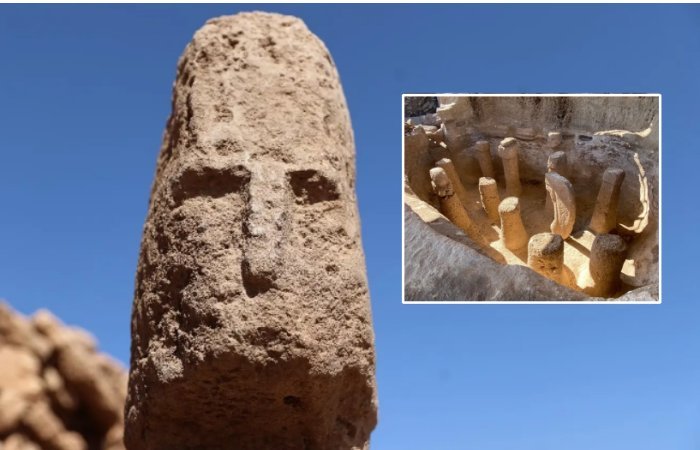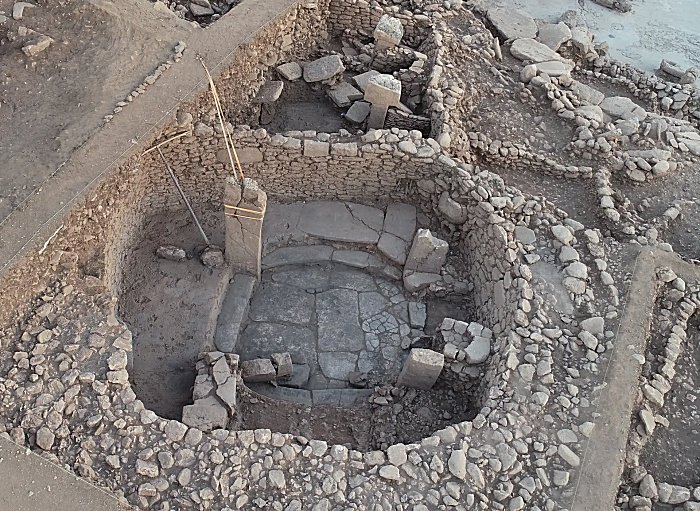Conny Waters – AncientPages.com – During this year’s excavations at Karahantepe, one of the leading Neolithic settlements under the Taş Tepeler Project, three T-shaped pillars were identified within a residential structure. The project is associated with
Archaeological excavations at Karahantepe, one of the key Neolithic settlements in the southeastern province of Şanlıurfa, Turkiye. Image source
Karahantepe, situated 60 kilometers east of Sanliurfa, itself is steeped in a rich past that stretches back 12,000 years and is thought to be the ancient city of Ur Kasdim, or the City of the Chaldeans.
It was during surface surveys in 2017 that Karahantepe first came to the attention of researchers. Today, the archaeological works continue over an area of 6,000 square meters.
The discovery of T-shaped pillars from the Neolithic period, dating between 10,000 and 6,000 B.C., significantly enhances our understanding of early human civilization. So far, nearly 250 of these pillars have been uncovered. Each pillar serves as a silent testament to an ancient era that continues to hold meaning in contemporary studies of human history.
The region of Şanlıurfa is considered sacred by Jews, Christians, and Muslims. According to the Old Testament, the Prophet Abraham, the “father of the three monotheistic religions,” was born in the city of Ur Kaśdim and migrated with his family to Harran, the “House of the Patriarchs.” Şanlıurfa was one of the cities of the Hurrian Empire in the 2nd millennium BC , and represents a rich heritage of many ancient civilizations dating back millennia.
The 12,000-year-old T-shaped pillar featuring a human face discovered at Karahantepe in southeastern Türkiye, Oct. 6, 2025. Image credit: Ministry of Culture and Tourism
Some believe that Abraham was born in a cave near the site of the Mevlid-i Halil Mosque. Therefore, the area and the cave are considered sacred. Additionally, we have to remember that also other famous Neolithic sites, such as Göbeklitepe and Nevali Çori, are located in the same area in such close proximity. Recent archaeological studies led by Professor Dr. Necmi Karul, suggest that Karahantepe may be even earlier than Göbeklitepe. This makes it the world’s oldest known Neolithic site.
The recent discovery of a human face depiction on one of the T-shaped pillars at the Karahantepe excavation site in Sanliurfa strongly supports the theory that these stones may indeed represent human figures.
On the side surface of one of the stones, the team found a human face with eye sockets, a nose and distinct facial features. This discovery even more supports the view that the horizontal part of the T-shaped stones represents the “head.”
Karahantepe Project Archive, Bekir Köşker ve Yusuf Aslan. Image source
The vertical part the structure was built on the ground, with its walls, covered with clay and its floor was paved with flat stones, as informed Professor Necmi Karul, head of the Karahantepe excavations.
There are also carefully arranged areas within the space. In these areas, there are cylindrical stone slabs on the floor, niches, and stone vessels placed in the walls. The floors of the buildings are covered with terrazzo or large stone slabs that are overlapped.
Karul pointed out that the pillars placed inside the dwelling were smaller than those in public areas, saying, This shows that “they had a load-bearing function for the roof but also had their own symbolic meaning within the houses. It reveals that their surfaces were decorated.”
He emphasized that each new artifact unearthed in the region is highly significant for the course of the long history of the region. Undoubtedly, the human face depiction is significant part of the discovery.
Image source
“From the reliefs on the side surfaces — the arm and hand reliefs, the best examples of which are in Göbeklitepe — we had suggested that they symbolize humans, that beyond carrying the roof they had a symbolic meaning, with the upper horizontal part representing the head and the vertical part the body. This finding clearly supports that idea,” Karul explained.
“If you look closely, the front surface of this ‘T’ has a sculpted human face. The facial expression, eye sockets, nose and sharp contours exactly match the depictions we see in the statues. The presence of a face, together with the arms and anthropomorphic reliefs seen on other statues, serves once again as evidence and clearly shows that these pillars symbolize humans.”
Karul added that excavations at Karahantepe have gained significant momentum under the Taş Tepeler Project and the Heritage for the Future Project launched by the Culture and Tourism Ministry in 2021.
Written by Conny Waters – AncientPages.com Staff Writer








Recent Comments